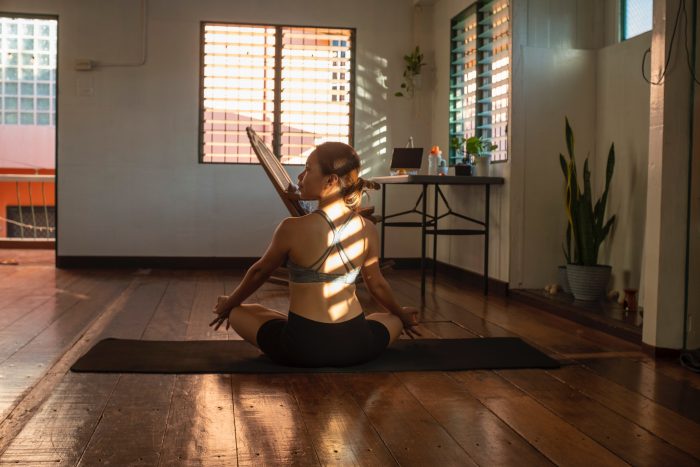The year 2020 saw the whole world coming to a standstill, and the online world came alive like never before.
I never thought I would be teaching or learning yoga online. The dark clouds of the pandemic came with a silver lining: I could attend other teachers’ classes, which were not accessible earlier due to their location or timings. I also got an opportunity to teach people from different cities and time zones—all from the comfort of my home.
I have been teaching online yoga for almost a year.
These are the six guidelines that have helped me better deliver an interactive online yoga experience:
1. Get the angle right through trial and error
The number one necessity for delivering online yoga classes is to get the right camera angle, both for the students and teacher. In studio classes, students get a 360 view of the asana, or yoga poses, so with using few instructions, they can easily get the alignment right.
In online classes, however, students need to be far enough from the screen to get a good view of the asanas as well as the transitions of each posture, whereas the teacher needs to be closer to the screen to be able to observe their students closely. While demonstrating the poses, the teacher can also step a little further so that their students can see them better, while students can take a step closer whenever they need to.
Also, make sure to set the lighting, get a few plants, see that you don’t camouflage into your background, and relax. Remember, you can always adjust the camera. The perfect angle does not exist, rather, the teacher needs to move around and try different things to ensure optimum visibility.
2. Use a clear voice
Teachers, your voice is a critical factor in online classes. It is the anchor that will help your students stay present. Also, using simple instructions will help your students practice mindfulness.
Use a mic if your voice is not loud or clear enough, minimize the background noise and distractions, and be aware that in poses like Adho Mukha Svanasana, or Downward Facing Dog, your voice will travel backward, so make sure you position yourself in a way where you’re facing the screen while speaking.
3. Make it simple
We all love new vinyasa flows, or yoga sequences, as we want to teach our students new poses. But in online classes, we want the students to be composed, mindful, and have enough space to get into their meditative zone. Thus, keep the asana flow simple. Challenge them with variations, motivate them to hold the asana longer, and allow their breathing to slow down.
Try to find the balance between instructing, motivating, and holding silence. Keep it simple and avoid overwhelming them with too many instructions or complexities.
4. Use your own energy
A motivated teacher can raise the energy of the class. As yoga teachers, we have the responsibility to be aware of the energetic relationship with our students through using our voice and body language. It is our job to create a safe, sacred space for our students to practice.
So, bring your A-game to every class.
5. Be prepared with a backup video or YouTube link
Ideally, a good Wi-Fi connection is an absolute necessity for online classes; however, the teachers should be prepared for technological glitches. For example, the students’ or teacher’s Wi-Fi connection might be interrupted, which leads to interrupting the flow of the class. Having a backup video or a private YouTube link will allow the students to flow with ease, regardless of any glitches.
6. Encourage your students to create their own yoga space
Yoga shouldn’t be another activity crammed into one’s schedule. These 60 to 75 minutes is your time to make space in your body and mind.
Encourage your students to create a space that will help them remain calm. Suggest that they switch off their extra gadgets, shut the door, put a “Do not Disturb” sign, and do whatever is necessary to make it their happy, sacred place.
For example, I personally like lighting scented candles and keeping various crystals in my teaching space to set the vibe of the room. I use the same room for my practice and teaching, and somehow, as soon as I lay out my mat, I instantly get into my mindful space.
These small pointers will make the online experience more rewarding for the students and teachers. Remember, students have signed up for an interactive class—not just a video class. So, personalize it and make it worth both your students’ and your time.
We are all still learning how to make the best out of our online classes. Your students understand this, so stay calm if any technological or home glitches happen. We all improve with time.







Read 6 comments and reply